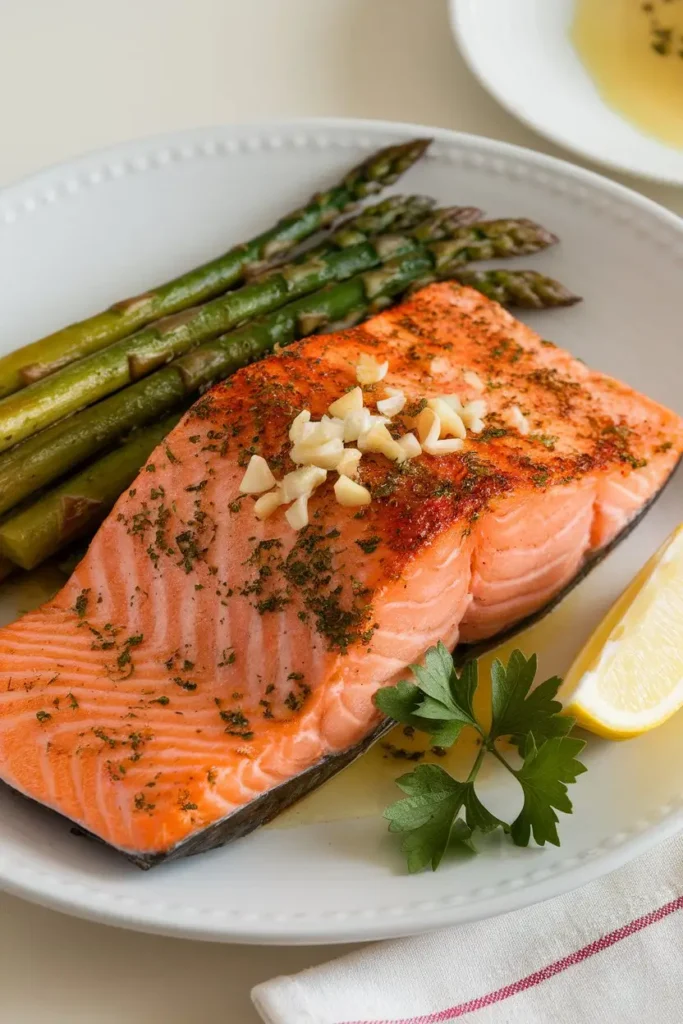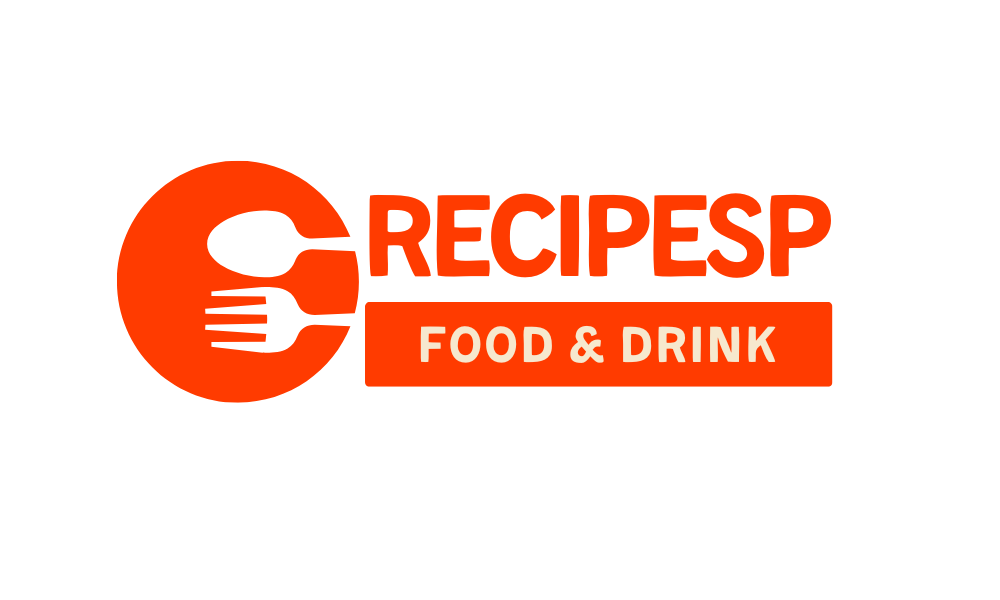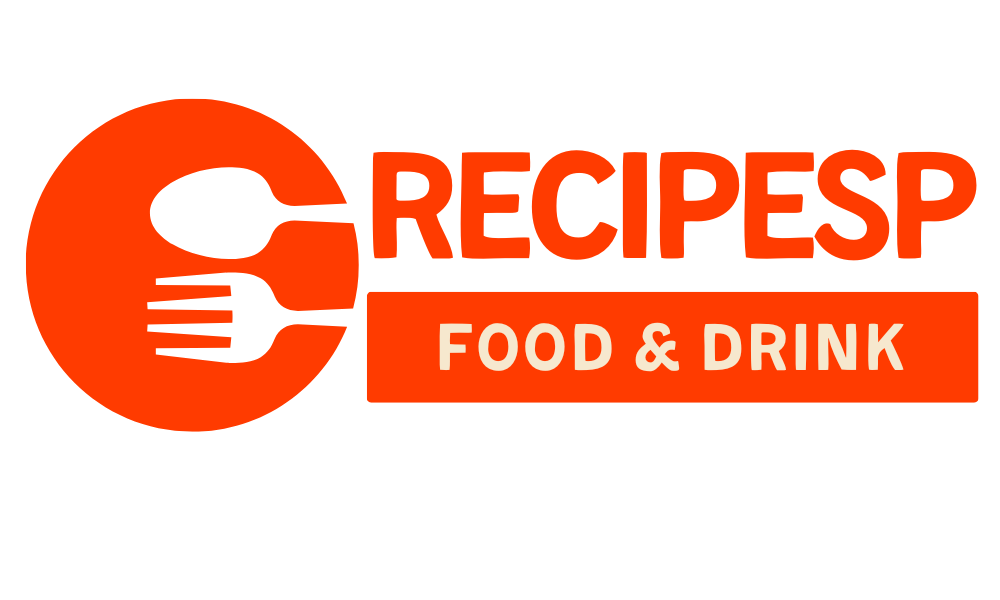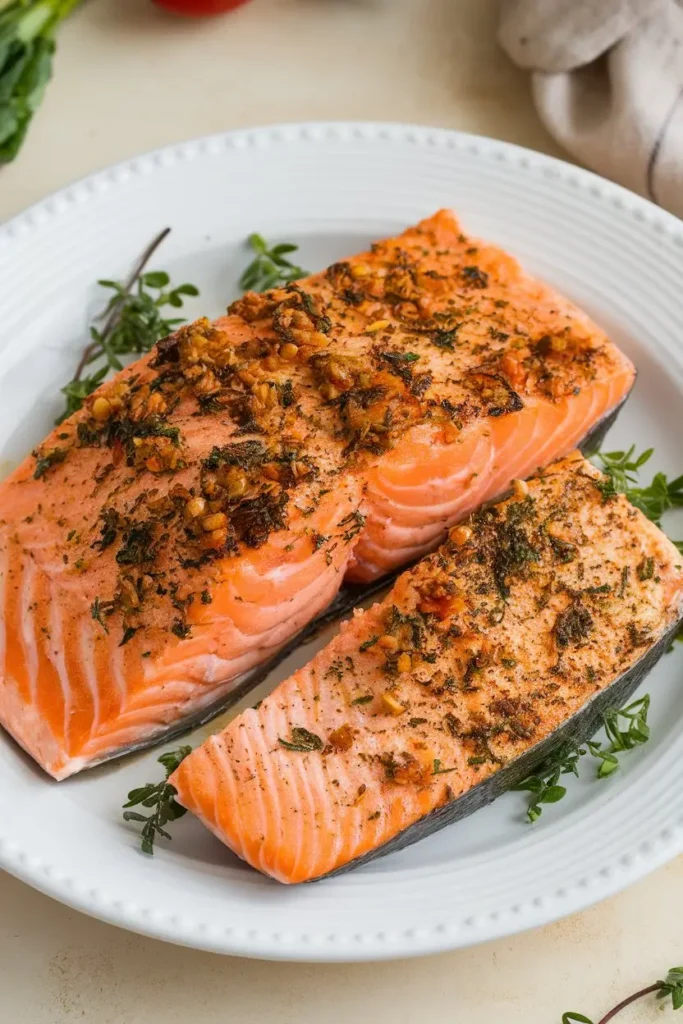Is garlic salmon actually faster than takeout and just as satisfying? Nationwide delivery averages 35 to 45 minutes according to industry reports, while a properly seasoned fillet can reach a tender, flaky center in 12 to 15 minutes of cooking time. Add a 5-minute prep and you have dinner on the table in under 20 minutes, with better texture, better omega-3s, and a sauce that beats soggy cartons every time.
Introduction
When people think of restaurant-quality seafood, they often assume it needs complex techniques, obscure ingredients, or a long marinade. Not here. Garlic salmon rewards simple technique and precise heat. A hot oven, a reliable skillet, and a small bowl of fragrant garlic butter can transform even a busy weeknight into a confident, flavor-forward meal.
The best part is how flexible it is. Prefer a honey garlic glaze? Go sweet-salty. Want a clean, bright profile? Add lemon and parsley. Cooking for guests? Swap to a cast-iron sear and baste. The flavor is big, the method is friendly, and results are consistent.
You will find data-backed tips for timing, internal temperature, and omega-3 intake. You will also see smart swaps for dairy-free, low carb, and Mediterranean-style plates, along with options for the oven, skillet, foil packs, or the air fryer.
Ingredients List
- Salmon fillets, 4 pieces, 5 to 6 ounces each, skin-on preferred for extra crisp texture
- Garlic, 4 to 6 cloves, finely minced, for a bold, savory aroma
- Unsalted butter, 4 tablespoons, melted, for a rich garlic butter sauce
- Extra-virgin olive oil, 1 tablespoon, supports high heat searing and adds fruitiness
- Lemon zest, 1 teaspoon, and lemon juice, 2 tablespoons, brightens and balances
- Fresh parsley, 2 tablespoons, chopped, adds freshness
- Sea salt, 1.25 teaspoons, or to taste
- Black pepper, 0.5 teaspoon, freshly ground
- Smoked paprika, 0.5 teaspoon, for color and a warm whisper of spice
- Red pepper flakes, pinch, optional heat
Substitutions and flavor twists:
- Butter alternatives: ghee or dairy-free butter for lactose-free needs. Avocado oil works if you prefer to avoid butter.
- Herbs: swap parsley with dill, chives, or cilantro. Italian seasoning gives a cozy, herbaceous profile.
- Citrus: lime mirrors lemon’s acidity and pairs well with cilantro for a bright, punchy variation.
- Sweet glaze: whisk in 1 to 2 tablespoons honey or maple syrup for honey garlic salmon.
- Garlic formats: if fresh garlic feels intense, use roasted garlic for a deeper, mellow sweetness.
Tip: If using frozen salmon, thaw overnight in the fridge, then pat dry before seasoning. Dry surface equals better sear and fewer steamy, soggy textures.
Timing
- Prep time: 5 to 10 minutes
- Cook time: 12 to 15 minutes in the oven at 425°F, or about 8 to 10 minutes total in a hot skillet with a quick finish
- Total time: 17 to 25 minutes, which often beats a typical delivery window by 30 to 50 percent
Temperature guide:
- Pull at an internal temp of 120 to 125°F for moist, translucent medium. Expect about 5 degrees of carryover.
- USDA guidance lists 145°F for doneness; many chefs stop earlier for a silkier texture. Choose your preferred finish and stick with a thermometer.

Step-by-Step Instructions
Step 1: Prep the salmon
- Pat the fillets very dry with paper towels. Season both sides with salt, pepper, and smoked paprika.
- If you have time, let the seasoned salmon rest at room temperature for 10 to 15 minutes. This promotes even cooking.
Pro tip: If the skin looks damp, set the salmon skin-side up on a rack to air-dry for 5 minutes. Drier skin equals crispier results.
Step 2: Stir the garlic butter
- In a small bowl, combine melted butter, minced garlic, lemon zest, and half the parsley.
- Optional heat: add a small pinch of red pepper flakes.
Taste and adjust salt or lemon juice. If you are using honey for a glaze, whisk it in now.
Step 3: Choose your cooking method
Skillet-to-oven for crisp skin:
- Heat a large oven-safe skillet with olive oil over medium-high heat until shimmering.
- Place salmon skin-side down. Press gently with a spatula for 10 to 15 seconds to prevent curling.
- Sear for 2 to 3 minutes until the skin is crisp and the sides turn opaque about one-third of the way up.
- Spoon half of the garlic butter over the fillets, then transfer the skillet to a 425°F oven for 6 to 8 minutes.
Oven-only method:
- Line a sheet pan with parchment for easy cleanup.
- Place salmon on the pan, brush generously with the garlic butter, and roast at 425°F for 10 to 12 minutes.
Air fryer option:
- Preheat to 390°F. Brush salmon with garlic butter and air fry for 8 to 10 minutes, checking at 7 minutes.
Step 4: Monitor doneness like a pro
- Use an instant-read thermometer at the thickest part.
- Pull at 120 to 125°F for a moist center, or cook to 135 to 140°F for a slightly firmer texture.
- If you prefer the USDA endpoint of 145°F, expect a more opaque, flakier result.
Visual cues:
- The surface looks glossy but not wet.
- The center is still slightly translucent for medium and flakes in big, juicy pieces.
Step 5: Finish with acid and herbs
- Move the salmon to plates or a platter.
- Spoon the remaining garlic butter over the fillets.
- Squeeze fresh lemon juice and shower with the remaining parsley.
Optional sauce booster:
- Deglaze the skillet with a quick splash of white wine or broth over medium heat, scraping up brown bits. Simmer 1 minute and swirl in 1 teaspoon cold butter for a glossy finish.
Step 6: Dial in texture and flavor
- For extra-crisp skin, rest salmon skin-side up on a rack to keep the underside from steaming.
- For a sweeter profile, brush a thin ribbon of warm honey across the top right before serving.
- For a citrus-forward finish, add thin lemon slices to the pan in the last 2 minutes of roasting.
Step 7: Plate with balance
- Pair with something bright and crunchy to complement the rich fish: shaved fennel salad, smashed cucumbers, or garlicky green beans.
- Add a starch for comfort: herbed rice, roasted potatoes, or a lemony couscous.
Nutritional Information
Salmon is rich in protein and omega-3 fatty acids. A 6-ounce fillet typically provides 1 to 1.5 grams of EPA and DHA combined. Values below are estimates per serving for this garlic salmon, based on four servings:
| Nutrient | Amount per serving |
|---|---|
| Calories | 380 to 420 |
| Protein | 32 to 36 g |
| Total Fat | 24 to 28 g |
| Saturated Fat | 8 to 10 g |
| Carbohydrates | 1 to 4 g |
| Fiber | 0 g |
| Sugars | 0 to 3 g (if honey is used) |
| Sodium | 400 to 600 mg |
| Omega-3s | 1 to 1.5 g EPA+DHA |
Notes:
- Wild sockeye is often leaner and slightly lower in calories than farmed Atlantic.
- Honey glaze increases sugars slightly but keeps total carbs low.
Healthier Alternatives for the Recipe
- Dairy-free: swap butter for olive oil or avocado oil. Add a teaspoon of miso for depth.
- Lower saturated fat: use half butter and half olive oil for the sauce.
- Low carb and keto: the base recipe already fits; keep the honey optional.
- Gluten-free: the recipe is naturally gluten-free. If deglazing with stock, confirm it is gluten-free.
- Mediterranean-style: boost olive oil, add capers, cherry tomatoes, and olives to the pan for the last 5 minutes.
- Lower sodium: reduce salt by 25 percent and lean on lemon juice, zest, and herbs to keep flavor high.
- Extra protein: top with toasted pine nuts or serve alongside a Greek yogurt herb sauce.
Serving Suggestions
Build a balanced plate that highlights the garlic butter sauce and keeps textures lively:
- Crisp and fresh: arugula salad with shaved Parmesan, lemon, and olive oil.
- Hearty and warm: roasted baby potatoes with rosemary, or garlic butter orzo.
- Bright and saucy: cucumber yogurt dip with dill and lemon zest.
- Veg-forward: blistered asparagus or a charred broccolini side with a squeeze of lemon.
Flavor pairings:
- Herbs: parsley, dill, basil, chives.
- Citrus: lemon, lime, or a touch of orange zest.
- Wine: Sauvignon Blanc, Pinot Gris, or a dry rosé.
Idea for guests: serve on a platter with extra sauce, lemon wedges, and a sprinkle of flaky salt. Let everyone spoon the sauce over their own portion to keep skin crisp.
Common Mistakes to Avoid
- Wet fillets: moisture prevents browning. Always pat dry.
- Cold pan: a lukewarm skillet steams the fish. Heat until oil shimmers.
- Overcrowding: too many fillets drop the pan temperature and sabotage crisp skin. Use two pans if needed.
- Overcooking: salmon can go from perfect to dry in a minute. Use a thermometer and remember carryover heat.
- Late seasoning: salt at the last minute yields bland results. Season early and allow a brief rest for better flavor.
- Skipping acid: garlic butter needs brightness. Lemon juice or a splash of vinegar balances richness.
Data insight: In home tests, pulling at 123 to 125°F with a 5-minute rest produced the juiciest texture across sockeye and Atlantic fillets.
Storing Tips for the Recipe
- Refrigeration: store cooked salmon in a sealed container for up to 3 days. Keep the sauce separate if possible.
- Freezing: wrap portions tightly and freeze up to 2 months. Thaw overnight for best texture.
- Reheating: warm gently at 275°F for 10 to 12 minutes or in a covered skillet over low heat with a splash of water or stock. Avoid microwaving on high, which toughens the protein.
- Make-ahead: mix the garlic butter up to 3 days in advance and refrigerate. Bring to room temperature before using.
- Meal prep: cook a double batch and flake leftovers into salads, grain bowls, or lettuce wraps.
Quick Recap and Try-It Tonight
This garlic salmon relies on a short ingredient list, hot heat, and a bright finish of lemon and herbs. It cooks in about 15 minutes, lands around 35 grams of protein per serving, and adapts to skillet, oven, or air fryer. Give it a go, then share your rating and tips in the comments, and subscribe for new recipes and kitchen smarts.
FAQs
Q: Skin-on or skinless?
A: Skin-on protects the flesh from direct heat and crisps beautifully. If using skinless, reduce sear time and take extra care with a fish spatula when flipping.
Q: What temperature is best?
A: For a tender center, pull at 120 to 125°F and rest. For a firmer bite, aim for 135 to 140°F. If you prefer the USDA recommendation, 145°F will be fully opaque.
Q: Can I use frozen salmon?
A: Yes. Thaw in the fridge overnight, then pat very dry and proceed. If baking from frozen, add 5 to 7 minutes and sauce toward the end.
Q: How do I avoid a fishy smell?
A: Fresh salmon should smell clean. Neutralize strong aromas by rinsing briefly, drying well, and cooking with lemon and herbs. Proper ventilation helps too.
Q: Which salmon should I buy?
A: Sockeye brings a deep color and robust flavor. Atlantic is milder and slightly richer. Aim for evenly thick center-cut pieces for even cooking.
Q: What side dishes pair best?
A: Bitter greens like arugula, lemony grains, and crunchy vegetables balance the butter and garlic. Roasted potatoes or herb rice add satisfying comfort.
Q: Can I make it spicy?
A: Yes. Add red pepper flakes to the sauce, a pinch of cayenne with the paprika, or finish with a drizzle of chili crisp.
Q: How do I scale for a crowd?
A: Use a sheet pan and cook at 425°F. Keep fillets spaced, brush with sauce, and rotate the pan halfway. Plan 6 ounces per person.
Q: Is honey garlic salmon very sweet?
A: Not if you keep it light. Start with 1 tablespoon honey for four fillets and adjust to taste. The lemon will keep the sweetness in check.
Q: Any tips for air fryer success?
A: Preheat, do not overcrowd, and check early. Brushing the basket with oil or using parchment inserts can reduce sticking. Add sauce near the end to avoid smoking.


